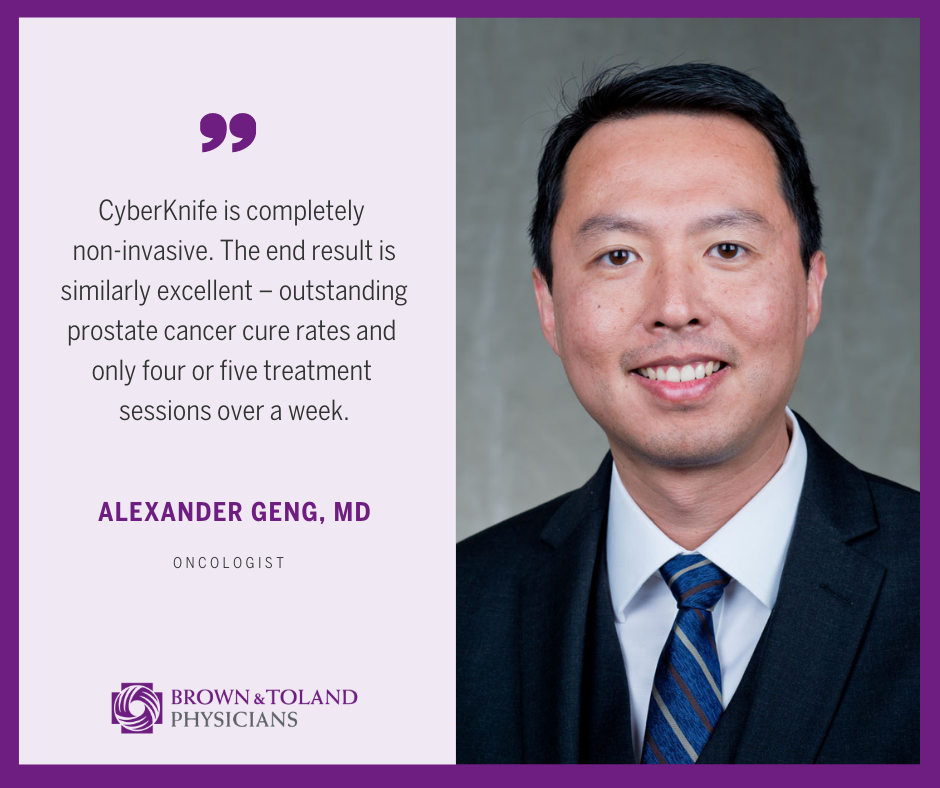CyberKnife: A Laser-Beam Focus on Treating Prostate Cancer

According to the American Cancer Society, one in eight men will be diagnosed with prostate cancer within their lifetime – and of those cases, one in 39 will prove to be fatal. However, with early detection, prostate cancer is very treatable, with both surgical and nonsurgical interventions. One of the most promising nonsurgical treatments emerging as a new option for prostate cancer patients is called CyberKnife®. This treatment uses targeted beams of radiation to the prostate, sparing the surrounding healthy tissue – including critical structures like the bladder and rectum.
We recently sat down with Brown & Toland oncologist Dr. Alexander Geng, an expert in treating prostate cancer with CyberKnife, to learn more.

You are a radiation oncologist. What led you to enter this field?
I have a background in electrical engineering. It’s a good matchup for radiation oncology, arguably the most technical field in medicine, where we aim beams of photons and electrons and bounce these tiny particles around to kill cancer according to principles of physics and mathematics.
I should also add I have always been interested in oncology. My original intention in medical school was to go into head and neck surgery, specializing in removing head and neck cancers such as throat or tongue cancers. When I realized many types of head and neck cancers can be treated and cured with radiation, I took a dive into radiation oncology.
Can you explain basically how the CyberKnife technology works? How is it unique?
CyberKnife is one of the most highly evolved forms of photon or X-ray-based radiation therapy. We have come a long way from the times of Madame Curie and using raw and toxic radioactive materials to treat cancer. The analogy in everyday life would be CyberKnife representing the modern day iPhone and early raw material radiation treatment representing a switchboard telephone.
A phone still functions as a phone. But an iPhone is a much better phone than a switchboard telephone and it does infinitely more things that couldn’t be done with switchboard technology. CyberKnife is a bit like that. It still delivers cancer killing X-rays but it does it with a precision and accuracy previously unimaginable — down to 60 microns, thinner than the average width of a hair. It also tracks cancers that move in the body, such as lung cancers that move with breathing, or prostate cancer that moves with bowel motion and bladder filling. All of this comes together to create a cancer treatment platform that enables precision killing of cancer with a very high success rate in treating tumors in the brain, spine, liver, pancreas, prostate and more without putting a single needle into the body. There is also no recovery time needed for the patient.
Is CyberKnife treatment new for the treatment of prostate cancer?
It is a relatively new modality of treatment for prostate cancer. But it’s also been around long enough to prove its track record and be considered a standard treatment aimed to cure prostate cancer.
How is CyberKnife treatment different from standard prostate cancer surgery? From conventional radiation therapy?
The CyberKnife evolved from brachytherapy, which also delivers very high doses of cancer-killing X-ray into prostate cancer. But brachytherapy is invasive and requires taking patients to the operating room and inserting many long needles deep into the pelvis, which will stay there for many hours on the day of treatment. The main difference: CyberKnife is completely non-invasive. The end result is similarly excellent – outstanding prostate cancer cure rates and only four or five treatment sessions over a week, in comparison to conventional radiation for prostate cancer, running typically to 38-45 treatment sessions over the course of two months or more.
Compared to surgery, the most apparent difference for a patient is, again, CyberKnife is non-invasive and has no recovery time.
What are the advantages of CyberKnife treatment for prostate cancer?
So, in short, CyberKnife for prostate cancer is the fastest treatment for prostate cancer – it can be completed in one week. It is non-invasive and requires no hospital stay. The cure rates are as good as surgery or even slightly better than other types of radiation treatment in patients who are appropriate for the treatment.
What are the side effects of CyberKnife treatment?
The most common short term potential side effects are urinating more frequently and/or having more urgency to urinate. Sometimes, patients might experience some increase in bowel movement frequency as well. There are some other uncommon side effects as well. Most of the common potential side effects are short-lived and resolve shortly after treatment.
What if a patients is not a candidate for CyberKnife treatment?
It really depends on “why” they are not. More often than not, patients who are unwilling and unable to have other forms prostate cancer treatment might still be a candidate for CyberKnife, either as their only treatment or a part of the overall treatment plan. In very high-risk or advanced prostate cancer, patients are usually not treated with CyberKnife, at least not initially. These situations tend to be complicated and require a lot of planning and collaboration among a team of cancer doctors to optimize and individualize the treatment course.
Alexander Geng, MD, is a board-certified radiation oncologist, specializing in Stereotactic Radiosurgery (SRS) and Stereotactic Ablative Radiotherapy (SABR) using the CyberKnife Robotic Radiosurgery System. Meet Dr. Geng and learn more about CyberKnife treatment here. To make an appointment, call San Francisco CyberKnife at 415.674.8200.
